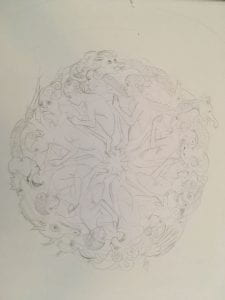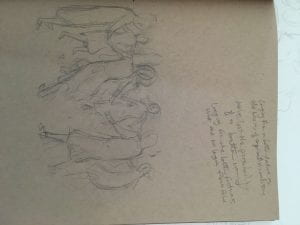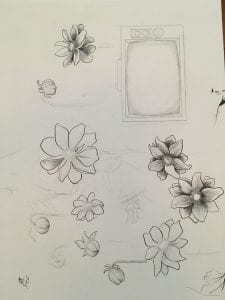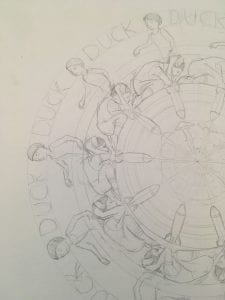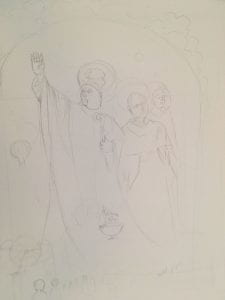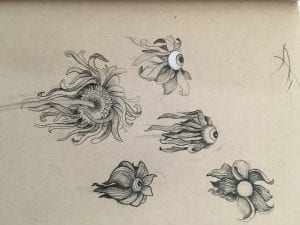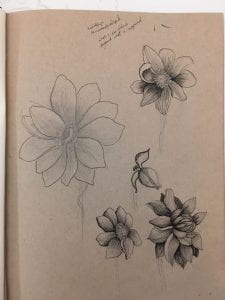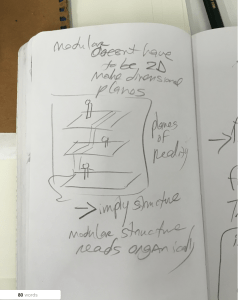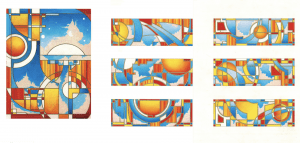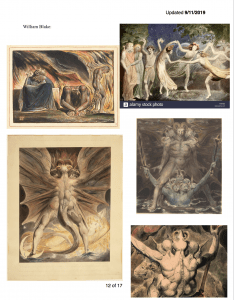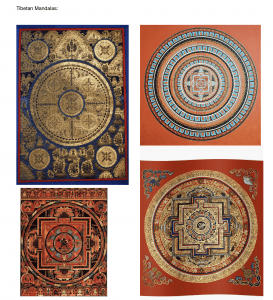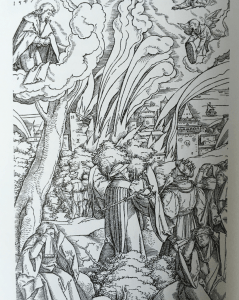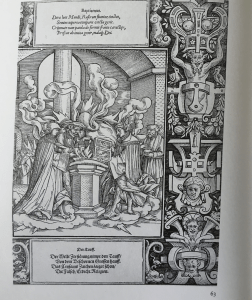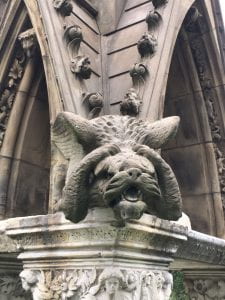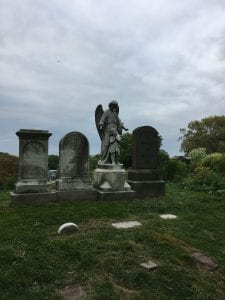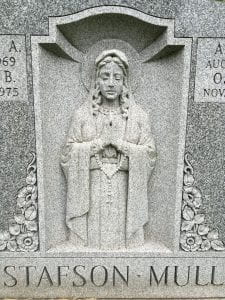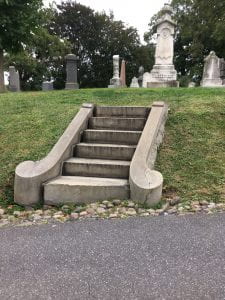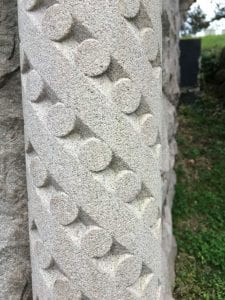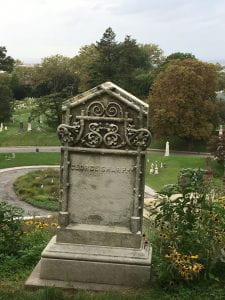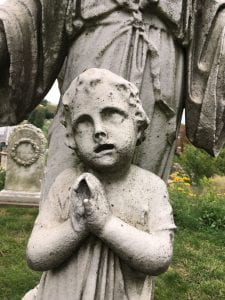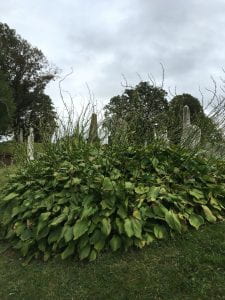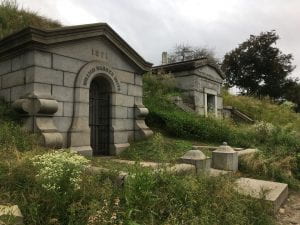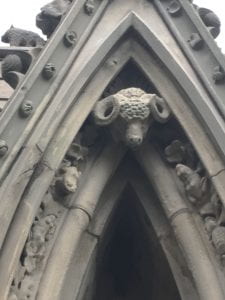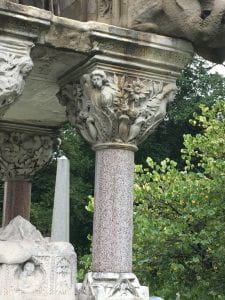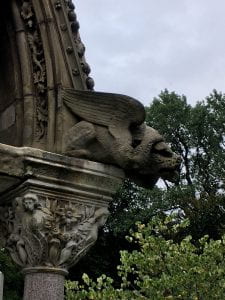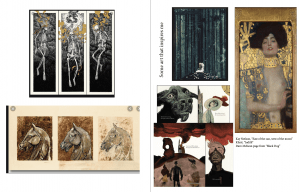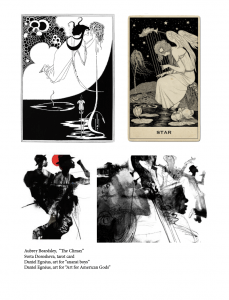First, the angst:
I feel frustrated with my project. The progress feels disjointed. This process of “cutting and pasting” unrelated images feels uncreative, tedious, and laborious. What is the connective tissue between the pieces? I’m having trouble finding subjects to draw. I’m having trouble finding reference photos. I’m sick of working from reference photos. I’m torn between forging forward and finding the connections later, or re-evaluating the premise of the project/focusing it more. I feel removed from my own creativity. I’m anxious and biting off my nails and now my finger nubs hurt. Is that too much information?
Now, the constructive part:
Lauren and I discussed some of these concerns. My creative process prior to thesis was to create these one-off “snapshots” of characters–no background, maybe with a decorative border or something. There was little experimentation with depth, background, or multiple characters engaging. Lauren suggested going back to this process of “doing what I like”, but diving deeper into the characters. How would they look from the front, back, side, sleeping, excited, sad, etc.? What is their backstory? How can that be expanded and mined for inspiration? What happens when the characters Interact? What happened before the image I created. What happened after? I can cut and paste them later.
Repetition of characters could be one way to create continuity and to build upon the pre-existing work for the project.
My process is to just keep making art. Eventually something will come out. Also, I really just want to draw animals. I’m going to draw 20ish happy bunnies now.
In the meantime, here are some progress photos. It’s nighttime and the lighting is terrible. I hope to replace these images with better ones soon.








Using the concept of Hauntology/Hontology/Ontology as a jumping off point, I will create a series of large pieces in pen and ink, and later compile these images into a book.
French Philosopher Jacques Derrida introduced this term: “Hauntology,” the study of being and non-being. It’s a merging of the two words:
Haunt: To appear in the form of a ghost
Ontology: the study of the nature of being
Hauntology is this idea that society is haunted by its lost futures, and because of this, we constantly look to the past to see how they imagined the future. As a result, we are caught in this cultural feedback loop. New Technology emerges, but there is cultural stagnation. This could be the reason that there is such a resurgence of 70’s, 80’s, and 90’s pop culture. Because we can’t imagine a positive future anymore, we look to nostalgia for comfort and context.
This topic is appealing because it has an inherent dichotomy: The study of being and non-being, the past and the future, the present and absent, positive and negative, old and new. I’m really interested in how the past viewed the future, and how our future sees the past. The 1700’s saw a future still with bustled skirts and powdered wigs, but with flying machines and trained seahorses to ride. The 1950’s saw the year 2000 as one with unchanging social constructs, but with technology inextricably linked to our lives: The woman is still a happy homemaker, but because of instant meals and disposable dishes, has more time to devote to homemaking/leisure. What is absent is also interesting: no sickness, no “blackness”, no poverty. The future as imagined by the past is a utopia for rich white people (at least from this U.S.-centric viewpoint). We have smart homes and convenience, but live in a state of social isolation. We have a healthy planet Earth, but a Mars vacation home to visit on the weekends.
In these futures, the family unit is self-contained. Because of the linkage of technological advances to daily life, there is little need for human interaction. Children are home schooled, mom does shopping online, dad works from home and occasionally phones in for a conference call. In some ways, I see parallels of past future visions and current life in NYC. In a city with 8 million people, there is little human interaction, and what little does happen is met with skepticism. People become a nuisance at best, and disposable at worst. Dating exists in the world of hookup culture, where people are a mere means to an end to the socially anxious and detached.
This disposable version of utopia fits into the current climate change emergency too (this thought needs elaboration). In the past, the future was imagined as an optimistic technological wonderland of knowledge and leisure. In reality, our world is dying: we’re in the midst of a mass extinction, the coral reefs are bleaching, the amazon burns, the weather becomes more extreme, the food and water supply become poisoned with plastics and chemicals. under these conditions, it’s hard to imagine any future. We are fragile beings, always teetering on the brink of annihilation. Yet, I want to be optimistic about the future. Humans are hardwired to do so. In a 2012 Scientific American article by Wray Herbert, he discusses peoples, “remembered futures.” He writes:
“The fact is that we all imagine the future, and from time to time we recall those imaginary scenarios. Recent research has shown that the same brain areas are active when we remember past events and when we think about the future. Indeed, some scientists believe that these “memories” are highly adaptive, allowing us to plan and better prepare ourselves for whatever lies in store.”
Looking ahead at the future is something that we are hardwired to do as humans. As conscious beings, we imagine the futures that never happened: the memories of life before, and the anticipation of the life after. It’s nostalgia for the future based on experiences from the past. The wedding ring that belongs to the widower of war becomes a symbol of a lost future with her late husband. The photographs from childhood can bring us back to our parents homes (for better or for worse). It’s a physical item that manifests memory. It’s the “what if’s” throughout history that haunt us as a species: What if Hitler won the war? What if we pursued electric cars instead of gasoline powered ones? What if life happened differently?
Hauntology manifest in music, not only retro sound, but in lyrics of longing and memory. I’ve always loved the band Pink Floyd because of this. Their lyrics address many societal disorders and mental illnesses. The members of Pink Floyd, haunted by the mental deterioration of original frontman Syd Barrett, devoted their 1975 album “Wish you were here” to him. In the title track, Roger Water sings:
“…Did they get you to trade
Your heroes for ghosts?
Hot ashes for trees?
Hot air for a cool breeze?
Cold comfort for change?
Did you exchange
A walk on part in the war
For a lead role in a cage?…
There is an longing in these words. The lyrics echo and ache as if trying to communicate through time and space. The album is a homage to the free spirits the members once were, and the record company cash cows they had become. The band traded one reality for another and became famous. Barrett traded one reality for another and disappeared.
Perhaps it’s human nature to want all possible versions of reality. I relate Hauntology to my own life as this sort of longing. I wonder what life would have been like had I stayed in Michigan in my own form of “cold comfort”. I wonder what life would have been like had my suicidal inclinations gotten the better of me. Reality means living as a ghost sometimes. When I visit home, I walk through the city as a ghost, same as I do in NYC.
I also think about the doomsday scenarios that my brother predicted, not once, not twice, but 3 times (he was positive that he has predicted correctly, and even sold off music equipment to purchase provisions). Maybe in an alternate reality one or more of these are true, rather than just possibilities.In thinking about the future, it’s hard to not think about the many predictions for the end of times. HP Lovecraft and HG Wells both wrote about their versions, the former being more steeped in occult, and the latter being more technologically dystopaian. Cults and organized religion alike use/have used doomsday predictions to gain/exploit followers. Heavens Gate, The peoples temple (Jonestown), and Televangelists (Pat Roberson), have all predicted the end of times (the first two predictions ending in mass suicides, and Pat Roberson predictions ending with lots of book sales–i assume). In the bible, the end of times is marked by the 4 horsemen of the apocalypse, the sinners being left on earth to suffer, and the righteous brought to heaven for eternal salvation.
Perhaps humanity’s obsession with the end of times is in part an obsession with our own mortality and fear of the great unknown—the life beyond death. My brief run-ins with religion have left me skeptical about any sort of biblical doomsday, let alone any sort of omniscient being in the sky. Doomsday was predicted as early as 300 CE by saint Martin of Tours. (will get better source)
As of now, the world still exists. Writers like Philip K Dick often questioned this concept though. His novels present future scenarios that blur the lines between reality and simulation. Adam Gopnick suggests that these versions of reality are more or less as mundane as life is now:
“…in the sense that, no matter how amazing or technologically advanced a society becomes, the basic human rhythm of petty malevolence, sordid moneygrubbing, and official violence, illuminated by occasional bursts of loyalty or desire or tenderness, will go on. [The] future worlds are rarely evil and oppressive, exactly; they are banal and a little sordid, run by a demoralized élite at the expense of a deluded population. No matter how mad life gets, it will first of all be life.”
I imagine the future as mostly the same as now, but with more anachronistic cultural trends, less empathy overall, and more environmental activism/awareness (likely out of necessity, as the planet will be in dire condition). I wonder if the children growing up now react against a childhood spent in front of a screen, and having their every moment broadcast online from birth. Will they reject the invasiveness of smartphones and social media? Or will they continue to go along with it, too subdued and unfocused to fight for change?
Visual Aesthetic:
Using the dichotomy of present and absent, I want to utilize positive and negative space to illustrate lost futures, imagines pasts, and current realities. One aspect of Hauntology as it relates to music is sound of a needle scratching against a record. It’s meant to make the listener aware that they are listening to a recording, rather than the live music. Perhaps aspects of this can be translated visually: exaggerated flatness, accentuation of the paper rips and tears, or the randomness of ink splotches.
Another idea is to bring in elements of Art Deco. I have a long history of making art with Art Deco motifs and architectural elements. Art Deco is the perfect embodiment for this opulent and technological future imaginings. “During its heyday, Art Deco represented luxury, glamour, exuberance, and faith in social and technological progress….Art Deco was a pastiche of many different styles, sometimes contradictory, united by a desire to be modern.”
I do wonder if there’s a way to bring in elements of Kids Book illustrations into this. Because i do want all possible realities, I also want the reality where I end thesis with a kids book to present to publishers, as well as large scale pieces to present to a gallery. I want both career paths, rather than having to choose one.
Visual Metaphors:
- Time: clock, hourglass, aging, shadows, movement, sequence,
- Past: ghost, shadow, echo
- Memory: brain, age, thought process, concentrations,
- Future: ghost of Christmas future, light, technology, utopian, shiny,
- Nostalgia: technicolor, retro, actor and director, memory is unreliable
- ghost: noise, translucent, erasure, scared, haunting,
- Feedback: short circuit, noise, static, crackle, abrupt stop, repeat,
- Haunt: run, hide, scare, paranoia, follow, stalk, looming large,
- utopia: happy, clean,. Rich, white, disposable, convenience, comfort, leisure, isolation,
- comfort: ignorance is bliss, blankets, easy, relax, maslow’s self-actualization
- Cancellation: red, stop, pause, erase, remove, wax off, forget, collective consciousness, memory
- Lost: wide-eyed, frantic, directionless, help me,
- convenience: gluttony, lazy, impatience, instant, easy
- TV: black and white, Technicolor, high def, 3D, babysitter,
- Music: record, 8 track, cassettes, CD’s, MP3, repeat, scratch, static, skipping tracks, feedback
- Fashion: trends repeat, 80’s and 90’s throwback, baggy jeans with vinyl, bell bottoms, recycled fashion (materiality and concept), fashion without context or reaction,
- Addiction: need, smoke, inject, snort, brain, high, withdrawl, equilibrium, overdose
Opposites to explore:
Black and White
Positive and negative
Present and absent
Dead and alive
Constant and fleeting
Bold and sketchy
Organic and synthetic
Idealism and dystopian
Known and unknown
Retro and modern
Optimism and pessimism
Action and inaction
Memory and oblivion
Famine and feast
Some Quotes to think about:
“the presence of the past is all around us”
“visionary nostalgia is paradoxically linked to a utopian future modeled after conservative values”
“… any attempt to locate the origin of identity or history must inevitably find itself dependent on an always-already existing set of linguistic rules or conditions.”
“Nostalgia for lost futures”
“ what the future might have been but is not”
“Recreating something new”
Other questions to ask. What will these look like in the future (as imagined by the present and the past?):
Mass shootings/Violence/Guns
Climate change
Extinction
Food supply
Medicine
A.I. integration/A.I. self-awareness
Social isolation
Overpopulation
Rigid Gender roles (or gender fluidity?
Access to water
Climate refugees
Disposable culture
Social Etiquette/Expectations
Mental Health/Approach to treating
Income disparity (or equalization)
Leisure life
What does the future look like beyond what we have imagined?
The Process:
I originally thought that creating collages to serve as reference for my ink drawings would be a great place to start. The reasoning being that Hauntology is a sort of pieced together form of thinking about the past and the future. What better way to represent this than clippings of images and articles from different decades? Lauren thought this would be a good route to go. My worry is that I would just be copying images without context, or not change the images enough to make them interesting/original.
Because I generally don’t work much in a large scale format, the process of drawing big has been really frustrating and anxiety inducing. My thought process now is to make small components to cut and collage into larger drawings. This will allow for different levels of flexibility: I cut out the pieces I like and use them, or I like what I end up drawing and just keep adding. This will still be in line with the idea of cutting and pasting components from different time periods (in the spirit of nostalgia and hauntology). By collaging separate components, I can build a framework for the larger drawings, and build volume 3-dimensionality within the pieces themselves.
This will allow some flexibility in planning as well help me get out of this creative block. I’ve found that the process of actually drawing helps to generate ideas. Because I have not been drawing, I’ve felt very stuck.
Notes from Lauren:
9/3
Look at Artist: Alexis Rockman. Take note of the realistic technique and commentary on humans relationship to nature.
Look up artists: Balthus, Georgio de Chirico
NYPL, Library of congress, and British Library all have Digital Archives that can be resources for futurism/retrofuturism
Use text to shape and hold the work together
Ask: what gives the work a coherent aesthetic?
Is there a certain place? Ie. The coral reef, NYC, a psychological state, something that never was?
imagine the future:
are t4here 5 different people with different ideas of utopia?
Think of the incredible strangeness/stillness, Motion frozen in time
Hauntology is the seed, but doesn’t have to the the entire work
Notes from Chang:
9/6
Look at the artists Cleon Peterson. Take note of the image construction, flat landscapes, shape and line, use of positive and negative space.
Look at Artist McBess. Take note of the visual narrative and full landscapes. Try “edge to edge drawing” (start drawing on one point on the paper and don’t stop until the page is full).
Notes from TA’s:
9/6
Maricarmen suggested looking at Philip K Dick books (or movies) for inspiration on sci-fi dystopian futures. Much of his work revolves around “eroding realities” and the question of “What is real,” particularly as technology becomes intertwined with existence. He also incorporates the psychology of Jungian archetypes, mental illness, police states, and dissociation with reality/realities..
She also suggested that incorporating Art Deco motifs could be cool. In a way, I could be “reimaging Art Deco” from the view of Hauntology.
Random Thoughts:
What do we gain by asking “what if”?
We have lost the possibility of a better future
New Tech causes resistance. What are we afraid of? (NPR, Throughline, “Resistance is futile. What does memory look like? 






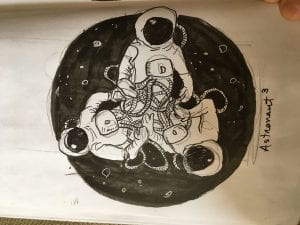
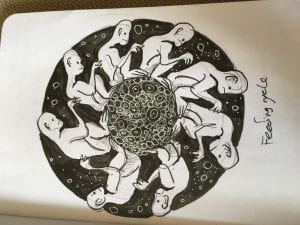






GENERAL
End Result: Overall, I want the thesis project to push me to use ink own a larger scale, be it in book form (Quantity), or physical size (quality). I am interested in creating something with a semi-commercial appeal.
How to challenge myself: Create art that is narrative and conceptual, that portrays a range of emotions
PROPOSALS:
Project Proposal 1: A kids book: “Marin and The Mushrooms”
Why: I believe childhood is inherently traumatic. One can have a perfectly normal and happy upbringing, but there is always a feeling of powerlessness. A child is at the mercy of their parents—the emotionally damaged byproducts of a different generation, or their own imagination—where monsters run rampant. Years ago, I made a collection of works around this theme called, “Bedtime Stories and Other Disturbances.” In this collection, I portrayed the nightmare that is childhood: monstrous adults with animal heads, traumatic playdates, and the feeling of suffocation that arises from “hover parents.”
Books like “Where the wild things are” and “Epileptic” explore how two kids form alternate realities to escape into when real life becomes too hard to deal with. In “Epileptic,” David B. copes with his older brothers onset of epilepsy by drawing creatures and environment to immerse himself into. Throughout this story, the narrator weaves in and out of this imagined reality, wherein the line between the two blur. In “Where the wild things are,” Sendak’s character Max, feeling powerless in his own life, retreats into an imagined world in which he has complete control over the monsters.
Story is a means to escape. This project is the opportunity to escape into my own imagined world. I imagine the character leaving their reality to one that is more palatable—at least on the surface.
The Format: When visiting the MET recently, I stumbled into a calligraphy exhibit. Religious books have long been a fascination to me, not because I believe in the stories, but because I see them as works of art. These books were Qur’an’s. They were richly illustrated with architectural motifs, calligraphy, and gold leafing. I want to incorporate some elements of old illuminated manuscripts and religious books into an original kids book story.
The creative challenge inherent in this is: how do I make a sophisticated “art book” appealing to kids, both visually and story-wise. How do I address complex emotions in a way that is palatable? How do I merge the realistic with the fantastical?






Project Proposal 2: A series of Narrative Illustrations revolving around the theme of Hauntology
Why: I recently learned about Hauntology. It’s this idea that we are haunted by our own lost futures. Looking to the past in the only way we can imagine a future. We look to see what previous generations imagined a future would be, thus recycling old ideas, rather than inventing new ones. I’ve noticed a cultural nostalgia ever-present in current pop-culture: TV shows set in the 80’s (Stranger Things) and 90’s revival in music and clothes. With climate change, war, and an increasingly hostile political climate, it’s hard to be optimistic about the future. By 2050 there will be more plastic in the ocean than fish. Flooding will lead to food and housing shortages. The future is uncertain. The past is safe. Nostalgia is more comforting than reality.
Illustrating these lost worlds would allow me to work with conceptual elements, symbolism, and sort through my own nihilistic views. What did people of the past think the future would be like? How did the culture at the time affect how the future was viewed? For the current generation, what does their future look like? How does our past influence our perceptions of the present? How does the present influence how we perceive the past?
The Format: The illustrations would be large format (18×24 or larger), with the presentation of a gallery exhibit. I want to challenge myself to work bigger, rather than making sketchbook-sized pieces. Because I use Pen & Ink and markers, large scale works intimidate me. I think i could work around this by planning out smaller drawing ahead of time, perhaps even using collage in the early drafts to add unexpected elements/scale/color.
By using pen and ink, I hope to evoke the artwork of old copperplate etchings. This archaic style is contrasted with a modern context of environmentalism and existentialism. These larger pieces could then be used to create a book about our lost futures that would serve an exhibition guide. I could make 5-10 pieces. I believe that I can stay engaged with this project for the semester (or year) since it will require a lot of research, in regards to both philosophical concepts of Hauntology, as well as documented historical opinions about the future.



Thesis proposal 3: The concept of home and the things that brings people comfort: a series of illustrations about the past and how one comes to terms with the present.
Why: The concept of home is something that I have trouble connecting to. Generic phrases like “home is where the heart is” invoke numbness rather than comfort. Distance and estrangement has created this void of “home.” Where is the heart when home is absent? My childhood home is gone, and my parents lost their house that only contained cold echoes. Why does one connect emotion to place? Does a house absorb the emotions of the people who dwell inside of it?
I compartmentalize my family. What is left is a fragmentation. My family is one of my own creation, patched together from a series of friends and surrogate parents. My biological parents are the base of this patchwork quilt. They are invisible but ever-present. I wouldn’t exist without them, yet they provided an unstable foundation for me to grow. I have to constantly work to stay stable and in tact.
The format: an expansive series of small illustrations portraying items that bring back a memory, each with a description of the memory (both good and bad). I’m thinking of 20-30 manageable sized pieces in pen and ink. Some works would be representative, some would be conceptual.
Concerns: This feels more like a personal project than a school project.






















